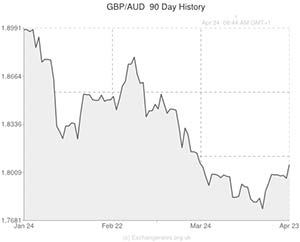
This week’s surprising Australian inflation data and disappointing Chinese manufacturing figures continue to keep pressure firmly on the ‘Aussie’ and the GBP to AUD pairing is clinging to recent gains.
There was a lack of Australian data overnight and the nation’s currency failed to recover recent losses against peers like the Pound, Euro and US Dollar.
The appeal of the Australian Dollar declined on Wednesday as domestic inflation data came in below the Reserve Bank of Australia’s 2-3 per cent target, lessening the odds of the central bank increasing interest rates in the near future.
As China is Australia’s most significant trading partner, the fact that the nation’s manufacturing sector contracted in April also took a toll on the ‘Aussie’.
Although the Australian Dollar has been known to bounce back from steep declines quite rapidly, the currency hasn’t done so on this occasion.
In the opinion of industry expert Andrew Barnett; ‘So we’ve come down to a key technical level around US 92.90 cents, what we’re waiting to see is some fundamental economic data. There isn’t anything I can see this week that is going to drive the Aussie Dollar lower, [but] At the moment the market is gun shy about whether it wants to pile back into the Aussie because the federal budget is coming up and now inflation is below 3 per cent people are saying maybe the RBA won’t put the interest rate up this year.’
The Pound, on the other hand, has largely retained last week’s employment-inspired gains and is trading in a fairly narrow range against peers like the ‘Aussie’, Euro and ‘Greenback’ ahead of tomorrow’s UK retail sales report.
The publication of minutes from the latest Bank of England policy meeting and UK public finance figures had little impact on the Pound yesterday.
However, later in European trading Sterling did receive some support from the news that UK business optimism was at an over 40 year high in April, with the CBI gauge jumping from 21 to 33 rather than achieving the 25 reading expected.
A CBI executive issued the following statement with the figures; ‘Confidence is rapidly rising among British manufacturers, with a real sense of business optimism. Our industrial base is seizing a bigger role in the UK’s economic recovery, with output, orders and hiring all on the up. Manufacturers plan to significantly ramp up investment in the year ahead.’
If tomorrow’s sales report confirms a 0.4 per cent month-on-month drop in sales in March the Pound could come under pressure before the weekend, but a surprising result may push the GBP/AUD pairing higher.
UK retail sales Update
The Pound extended its gains against the ‘Aussie’ after UK retail sales data came in above economist forecasts. Monthly sales increased by 0.1% defying forecasts for a decline of 0.4%. On a yearly basis overall retail sales advanced by 4.2%. As a result Sterling advanced to 1.81.
Australian Dollar (AUD) Exchange Rates
[table width=”100%” colwidth=”50|50|50|50|50″ colalign=”left|left|left|left|left”]
Currency, ,Currency,Rate ,
Australian Dollar, ,US Dollar, 0.9274,
,US Dollar, 0.9274,
Australian Dollar, ,Euro, 0.6704,
,Euro, 0.6704,
Australian Dollar, ,Pound, 0.5525,
,Pound, 0.5525,
Australian Dollar, ,New Zealand Dollar, 1.0789,
,New Zealand Dollar, 1.0789,
US Dollar, ,Australian Dollar, 1.0784,
,Australian Dollar, 1.0784,
Euro, ,Australian Dollar, 1.4921,
,Australian Dollar, 1.4921,
Pound Sterling, ,Australian Dollar, 1.8099,
,Australian Dollar, 1.8099,
New Zealand Dollar, ,Australian Dollar, 0.9285,
,Australian Dollar, 0.9285,
[/table]

Comments are closed.